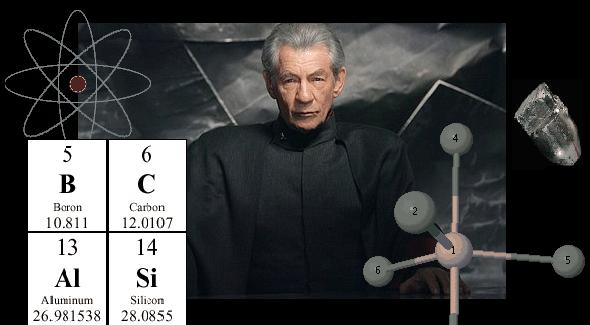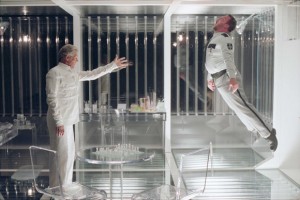[Please enjoy this delightfully overthought guest article from Colin Stevens. —Ed.]

Magneto is the pseudonym of one Erik Lehnsherr, a man with the ability to create magnetic fields and control metals. It’s one hell of a useful mutation to have, but it presents us with a bit of a problem that must be considered. Namely: what is it about metals that Magneto can control and why can he not control the other elements? We’ll have to look at several properties of metals. It might be useful to have your periodic table close by.
First thing to clarify is what exactly we mean when we say “a metal”. Defining it specifically, a metal is a substance which conducts more than 10,000 Siemens per meter. Metal has the ability to conduct electricity this well because of its structure when “in the bulk” i.e. when lots of the metal’s atoms are grouped together. Unlike non-metals which form strict chemical bonds where the atoms are positioned specifically, a metal features all its nuclei (central part of the atom) arranged in a lattice while the electrons (outer parts of the atom) are free to swim all over the structure.
It’s a bit like a bowl of Rice Krispies where the Krispies are the nuclei and the electrons are the milk. The electrons are free to move everywhere: they’re not fixed to one specific atom, which helps them to conduct electricity better because they can move so well (electricity being the property of moving electrons). At first we might think this is the property Magneto is exploiting, because it’s the only property that all metals have, perhaps he can control these delocalized “electron seas”? But this can’t be true because of one rather inventive scene in X-2 where Magneto escapes his plastic prison by sucking the Iron out of a prison guard’s blood after Mystique has injected him with it.
Apparently, Magneto required a certain amount of metal for him to use. Normal human bodies only contain 4.5g of metal, which we must assume Magneto could manipulate normally but which would not have been enough for him to build his floating platform as well as two bullets. (Although it does suggest that anyone suffering from Beta-Thalassaemia, a condition in which excessive iron uptake leads to an amount closer to 70 grams, shoudln’t be allowed to guard Magneto.) More importantly however, what it tells us is that he doesn’t need the metal to be “in bulk”; he doesn’t need a solid lump of metal for him to manipulate.

Sir Ian needs no help picking up a man.
In the body, iron is stored in four main proteins: Hemoglobin, Myoglobin, Cytochrome-C-Oxidase and Transferrin. All of them contain Iron as an atom. Iron in the blood (mostly Hemoglobin) is held in place via what’s called the Weiss model and involves a single atom of Iron having three of its electrons removed (a process called ionization) and bound in place by nearby Nitrogen atoms.
In other words, Magneto can control single atoms of metals—even metals that have been ionised. He doesn’t require metals to be in the bulk, so it’s apparently not their conductivity he’s exploiting, because iron in the blood doesn’t conduct. So it must be something else.
The first property worth considering is the metal’s magnetic properties. His name is Magneto, after all.
There are five main types of magnetism which elements can display, based on the arrangement of their electrons. Diamagnetism for instance is a property displayed by all solid materials, so it can’t be this or Magneto would be able to control lumps of coal (solid carbon).
The most obvious and familiar type of magnetism is called ferromagnetism (ferrum meaning iron in Latin) and arises from electrons all pointing the same way. But there are only five elements in this category (Iron, Cobalt, Nickel, Gadolinium & Terbium) and Magneto can control bullets which are usually a combination of Lead, Copper, Nickel, Antimony and sometimes Tungsten. So it’s not Ferromagnetism he’s using.
Ferrimagnetism and antiferrogmanetism are two other types, but they can be ruled out as they require atoms to be “in bulk”. Paramagnetism (the fifth kind) is temperature dependent and we have seen that Magneto can easily control metals on a warm day as well as in the coldness of Alkali Lake in winter. So although Magneto has the ability to create what are deemed “magnetic” fields, this must be a simplified explanation of what he can actually do because he’s creating some kind of field that all metals are affected by, irrespective of their magnetic characteristics.
If we rule out magnetic and conductive properties there are only two remaining parameters that generally distinguish metals from non-metals.
The first is ionization (the ability to remove electrons from the atoms). Metals are generally easy to ionize, but if this were the source of his power, Magneto would build up an enormous static charge every time he manipulated metals, and furthermore the metals themselves would become electrically charged. So when Magneto floats up the side of the Statue of Liberty, if he were ionising the metal around him somehow, he should be creating enormous static charges which would cause the metal to interact with other metal objects, not just him. We can thus rule out ionisation, leaving only one other property: the atomic shape.
If you look at a periodic table you can see it’s grouped into four “blocks” named the s, p, d and f blocks. These four blocks denote what type of shape the atom is (more specifically, it tells us what type of orbital the outer-electron is in, and the four different orbitals have different shapes so, it’s essentially the same thing). Most of the metals in the world are in the s, d and f blocks. This leaves the p block, made of all the “non-metals”, the “semi-metals” and 8 metals…which we’ll get to a bit later.
[NB: Hydrogen (the one electron atom) is sometimes placed in the s block, but it really doesn’t belong there as it shares none of the other s block properties. So we’ll assume that Magneto’s power requires there to be more than one electron in the atom he’s controlling (there are certain properties that >1 electron atoms gain which we don’t need to go into, but apparently Magneto’s powers are limited by them).]
Atoms in the s block are spherical, so whatever Magneto’s power is, it can manipulate spherical atoms. The d and f blocks unfortunately have two opposite types of shape however. The d block elements have what are called “gerade” shapes, which means if we turn the atom completely inside out, we have an identical shape. While the f blocks are “ungerade” meaning they cannot be pulled inside out to create the same shape. But nevertheless, if we look at the s, d and f atoms we have got most of the metals covered and we can actually distinguish them from the p block using group theory.
Group theory is a mathematical tool that puts collections of numbers (or physical shapes) into groups based on their collective properties. It’s commonly used in chemistry to classify molecules or atoms in terms of their symmetry (by symmetry, we aren’t just referring to whether they are mirror images of each other—we also need to consider things like rotational symmetry, i.e., can we rotate a shape around to give us an identical shape). If we consider the s, d and f blocks then we can classify them into different symmetry categories and using group theory, predict what geometrical features the p atoms have which the others don’t.
It can get a bit confusing, as the shapes in atoms aren’t always exact because they can distort and mix with each other upon bonding (as indeed iron does when it binds in Hemoglobin) but if we take this as our basis then the various p-orbitals can still be put into the groups that are separate from the s, d and f groups. This gets us as close as possible to accounting for Magneto’s metal controlling ability.
So what about the 8 metals in the p block? There are eight elements in the p block which are metals “in bulk” but in the atomic form have no magical properties. So these are metals, which Magneto should have no control over…so why was his prison not made of these metals? (Surely simpler than building a plastic facility)
Well, seven of them can be accounted for. Thallium, Lead and Bismuth are all highly toxic, so you can’t build a prison out of them; after a few months of touching the walls or breathing the air, he’d build up a high concentration in his blood and would die horribly (fair for a super-villain perhaps, but a breach of his mutant rights). Indium and Tin are both quite soft metals that can be pushed around quite easily, so not really ideal for making a prison. Gallium has the property of melting in the palm of your hand (melting point similar to that of chocolate) and so to escape Magneto could press against the walls and liquefy the cell.
Thanking her lucky stars she's not made of gallium. Though she did melt anyway.
Which leaves one element. It’s cheap, very common, can be made quite strong and is not particularly toxic that is also in the p block. Aluminium. Of course if we assume that there is some other property of Aluminium’s shape that allows him to control it, then we must remember that Boron (not a metal) has an identical shape and very similar chemical and physical properties. So if there’s something we’ve missed, Magneto should be able to control Boron as well. How can we account for this?
Thankfully we do have an escape clause. Nowadays, very little is actually made from pure Aluminium. Usually we use an alloy of Aluminium and another metal. (An alloy is a colloid of one metal suspended in another, like hot chocolate, where the milk is one metal and the chocolate powder is another—apparenlty milk is my go-to analogy in this article.) So when Magneto appears to be controlling aluminium, he must actually be controlling the other metal in the alloy. Even Aluminium foil is at best 99% Aluminium, so he must be controlling the 1% other metal! In fact, this could get us out of a lot of holes, because if he is ever shown controlling Lead pipes (sounds like something we’d see him do) then we can just claim it’s the other metal impurities. Magneto’s powers are demonstrably not magnitude dependent because he can extract one atom at a time from a person’s bloodstream, so a 1% impurity would be all he needs (far less in fact) to control pieces of aluminium.
Other interesting implications of this are that it tells us at least one property of Adamantium (the metal of Wolverine’s body). If we go with the comic canon it’s an alloy of steel and fictional metal Vibranium. The steel is mostly Iron so that’s how he can manipulate it. If we follow the film canon, then Vibranium is a metal found in meteorites and is in fact an element. We know from the foregoing analysis that it can’t be a p block element. Its minimum atomic weight must therefore be 119 (as all the other undiscovered metals are in the p block) making it very heavy and highly radioactive—but of course radioactivity wouldn’t bother Wolverine’s constant re-healing ability.
Another important implication: Magneto should be able to control Biothene, a naturally degrading plastic that contains Cobalt Stearate in a tiny amount. So while the government wants to fight Magneto, they’d better use environmentally unfriendly plastic to mold their guns. Otherwise there could be trouble!
Recall that Magneto cannot control Tin. This man may be our only hope of defeating him.
Whatever magnetic force you’re feeling—attraction or repulsion—sound off in the comments!
